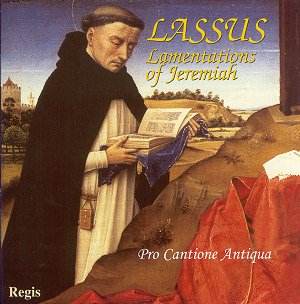The Lamentations are verses of the prophet Jeremiah
sung as lessons in the Holy Week Tenebrae services in the Roman Catholic
Church. A distinguishing feature is the inclusion of Hebrew letter-names
(Aleph, Beth etc.) at the beginning of the text of each verse. A further
characteristic is the exhortation to Jerusalem at the end of each section.
Early editions were written by Arcadelt, Isaac, la Rue and contemporaries.
Later settings were made by Carpentras, Palestrina and Victoria as well
as Lassus. The English contributions of Tallis are better known than
his pupil Byrd. 17th century settings were by Allegri and many solo
versions with continuo from Italy. The vogue seems to have run its course
in the latter half of the 18th century, although Alessandro Scarlatti,
Porpora and Jommelli composed contributions in Naples. In France after
1600, settings were made under the title leçons de tenebre
by Charpentier, Lalande and Couperin.
This one work takes the whole of one disc, and as can
be seen was never intended to be heard all at one sitting, but rather
as a series of "lessons", interspersed with psalms, readings
and motets. Certainly, although a long work it has a nobility and extremely
grave and serious aspect as befits the occasion. It does, however, make
for hard listening, even when sung as well as by Pro Cantione Antiqua.
There is one caveat to the performance; the work is written and sung
by menís voices, which involves counter-tenors taking the high parts.
At the upper part of their register these sound harsh and grating although
otherwise the singing and intonation sound extremely well. It does not
help that the normal timbre of the voices here is very reedy and penetrating;
this becomes more marked with the higher pitch. Other than this, the
performance is excellent, the ambience of St. Johnís Church is spacious
and the recording is as good as the original Hyperion. Incidentally,
this and Regis RRC1124 are still available on a Hyperion Dyad CDD22012,
but you will lose four pounds if you exercise that option. The booklets
are virtually identical, lacking only the German text translation on
the later disc.
This is a disc for Lassus admirers, or those who wish
to extend their knowledge of this fine composer.
John Portwood
